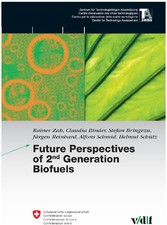Search and Find
Service
7 RECOMMENDATIONS (S. 239-240)
1 Promote in parallel vehicle efficiency and the sustainable use of 1st generation biofuels, 2nd generation biofuels and eMobility!
This study emphasized that different factors alltogether determine the overall potential of 1st and 2nd generation biofuels as well as of electric mobility: (i) the sustainability performance per value chain relative to the fossil reference, (ii) the available energetic potential per value chain and (iii) the conversion efficiency with which the feedstock is transformed into useful energy. The study also revealed that the implementation of electric mobility is an important option for partially replacing fossil based mobility: an additional 5% of the current Swiss electricity consumption could be substituted for approx. 26% of Switzerland’s fossil based mobility.
However, as the sustainability of e-mobility is strongly dependent on the type of electricity (coal, hydro, etc.) used, it is important to insist on a renewable and sustainable form of electricity production. The potential of increased fuel efficiencies in combustion-driven transport is a further central outcome of the study. Increased fuel efficiency not only directly decreases the dependence on fossil fuels per pkm and decreases GHG intensity but also significantly increases the outcome of the available biofuel potential, which indirectly further diminishes our dependence on fossil fuels.
This potential is however challenged by the continuing growth of our mobility demands but also by the increasing fossil burden caused by the transition from conventional to unconventional oil supply. Figure 126 shows as an example that the GHG balance for each of those factors is in the same range or greater than the maximum biofuels potential.
Figure 126 clearly demonstrates that a net benefit can hardly be achieved without increased efficiency, and a maximum benefit would require that all measures are applied in combination. 1st and 2nd generation biofuels and eMobility are complementary in their production and use, while pushing vehicle efficiency and biofuels leads to strong synergies. Consequently, the question for policy makers is not “bio-based, electric or more efficient mobility?” the key issue is about how to promote efficiency and develop the sustainable potential of the different technologies in parallel!
2 Develop a long-term biofuel strategy that gives the stakeholders regulative and legislative stability and therefore triggers new investments in the sector!
Currently, stakeholders are hesitant to invest in the various technology options for producing 2nd generation biofuels.
This is mainly due to an unpredictable and – to a large extent – not existing policy framework for 2nd generation biofuels. This leads to investments in established but out-dated technologies and hinders the penetration of more sustainable and efficient 2nd generation technologies. A long-term biofuel strategy is needed that provides the different stakeholders with a policy framework within which they can make their investment decisions.
All prices incl. VAT













